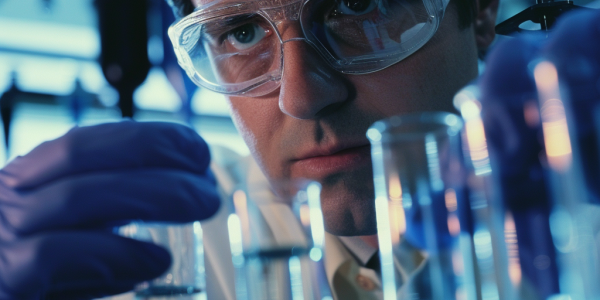Illinois Researchers Develop Eco-Friendly Method for Sustainable Chemical Production
Researchers at the University of Illinois Urbana-Champaign have pioneered a sustainable method combining light and enzymes to produce high-value chemicals. This eco-friendly approach, highlighted in the journal Science, leverages fluorine to enhance olefins used in various industries, including agrochemicals and pharmaceuticals. Led by Huimin Zhao, the study promises to revolutionize chemical production while minimizing environmental impact.
Breakthrough Method Developed to Decompose Toxic ‘Forever Chemicals’ Efficiently
Researchers at Ritsumeikan University have developed a groundbreaking method for decomposing toxic ‘forever chemicals’ (PFAS) using semiconductor nanocrystals. This innovative technique can completely break down harmful substances in just hours at room temperature, offering a promising solution to environmental pollution and health risks associated with PFAS. The method not only detoxifies but also recovers fluorine ions for industrial reuse, marking a significant advancement in environmental science.
New Discoveries Unveil Tycho Brahe’s Alchemical Secrets
Recent research has uncovered new insights into the alchemical practices of Tycho Brahe, the renowned 16th-century Danish astronomer. Archaeological analysis of glass and pottery shards from his lab at Uraniborg revealed high concentrations of elements like gold, mercury, and copper, suggesting complex experiments. This groundbreaking study not only sheds light on Brahe’s contributions to alchemy but also enhances our understanding of the evolution of chemistry during the Renaissance.
Pathway to Element 120 Discovered by Scientists
Scientists at Lawrence Berkeley National Laboratory have made a groundbreaking discovery that could lead to the creation of element 120. By utilizing a titanium beam for irradiation, researchers are advancing the quest for new elements, particularly in the realm of superheavy elements. This breakthrough not only addresses the challenges of synthesizing heavier elements but also opens possibilities for innovations in materials science and quantum computing.
Quantum-Enhanced High-Speed Camera for Molecules Developed by Scientists in Hong Kong
Discover the groundbreaking combination of quantum entangled light sources and ultrafast stimulated Raman spectroscopy in the development of a high-speed camera for molecules. Learn how this innovative technique enhances both temporal and spectral resolution in spectroscopic signals, enabling ‘high-speed imaging’ of ultrafast processes within molecular systems. Explore the significance of stimulated Raman spectroscopy in offering a more efficient alternative to traditional methods for analyzing molecular dynamics and interactions.
Revolutionary Carbon Capture Technology Freezes CO2 in Ocean Faster and Safer
A breakthrough study from The University of Texas at Austin introduces a revolutionary carbon capture technology that freezes carbon in the ocean faster and safer than ever before. This chemical-free method accelerates the conversion of CO2 into hydrates for ocean storage, providing a more efficient and eco-friendly alternative to traditional injection. Lead researcher Vaibhav Bahadur highlights the importance of this innovative solution in combating climate change by rapidly sequestering carbon dioxide in the ocean, preventing its release back into the atmosphere. Published in ACS Sustainable Chemistry & Engineering, this research signifies a significant advancement in carbon capture technology with the potential to address the challenges of global warming and enhance climate resilience.
Revolutionary Technology Allows Unprecedented Insights into Catalysts at Atomic Level
Berkeley Lab’s groundbreaking new technology offers unprecedented insights into catalysts at the atomic level, shedding light on essential electrochemical reactions powering technologies like batteries and fuel cells. The specialized polymer liquid cell coupled with transmission electron microscopy allows real-time observation of catalyst surface atoms interacting with liquid electrolytes, enabling researchers to track composition changes at different stages. This innovative approach not only deepens understanding of catalytic processes but also holds promise for enhancing the efficiency and sustainability of diverse technologies.
Scientists Unlock Mysteries of Promethium’s Chemical Properties
Scientists at Oak Ridge National Laboratory have made a groundbreaking discovery regarding the radioactive element Promethium, shedding light on its elusive chemical properties. By creating a pure isotope of Promethium-147 and utilizing X-ray spectroscopy, researchers have gained valuable insights into the element’s behavior. This achievement marks a pivotal moment in scientific exploration, offering a deeper understanding of lanthanide elements and paving the way for future innovations.
Revolutionary Vortex Fluidic Device Creates Gold Nanoparticles Without Harmful Chemicals
Researchers at Flinders University in South Australia have developed a groundbreaking method to create gold nanoparticles using a vortex fluidic device without harmful chemicals. This innovative approach not only produced nanoparticles but also revealed a contact electrification reaction in water, generating hydrogen and hydrogen peroxide. The environmentally friendly and efficient process offers potential applications in various fields such as drug delivery, catalysis, sensing, and electronics.
Advancement in Photon Emission Control Technology at University of Twente
Researchers at the University of Twente in the Netherlands have made a groundbreaking advancement in photon emission control technology, potentially revolutionizing the efficiency of portable screens and electronic devices. The team introduced a new device that can precisely regulate the emission of photons with unparalleled accuracy, leading to smartphones that require less frequent charging and potentially lasting an entire week on a single charge. This innovative technology has the potential to enhance the performance of miniature light sources, improve sensor sensitivity, and create stable quantum bits essential for quantum computing applications.










